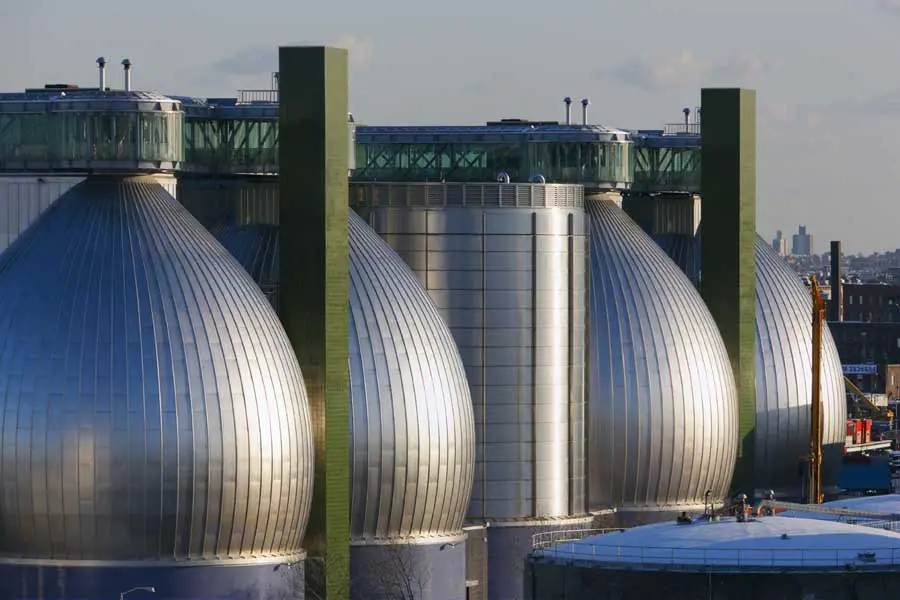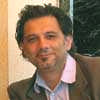Architectural Beauty, François Lévy Architect, Architecture Article, Building Design
Architectural Beauty
Architecture Discussion – article by François Lévy
26 Apr 2011
The Necessity of Beauty
“Great art likes chains,” said Nadia Boulanger. Applying Boulanger’s assertion to design begs the question: what is the nature of the chains that contribute to the most satisfying architecture? Fortunately, there is no lack of constraints in architecture. There are always external limitations, to which designers invariably add their own self-imposed chains, consciously or not.
It may be that we react positively to the expression and celebration of structure, for example, precisely because such architecture acknowledges that constraints—here the limitations of statics—are inherently satisfying. The more accessible the constraint, the more it alludes to intuitive human knowledge, the more architecture is legible and satisfying to its users. And when faced with examples of nearly unfettered architecture—limitless sites, a nation’s treasury for a budget, and no restraints—the result is often vacuous; witness Versailles.
To the familiar constraints of site, budget, structure, program, and so on we have more recently consciously added that of energy use. In fact, however, that constraint too is an age-old one. It may have once appeared as if we had limitless resources, but that is at most a century-old illusion, and one that is fast dissolving. The story of civilization and its built environment could be told as a narrative of resource management. Three recent projects directly or implicitly engage resources as their central theme.
Newtown Creek Wastewater, Brooklyn, NY
Ennead Architects
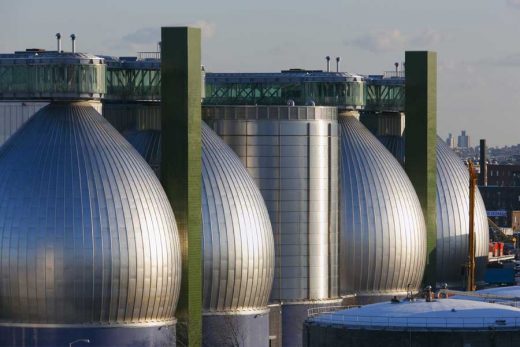
image : Jeff Goldberg/Esto
Ennead Architects’ Newton Creek Wastewater Treatment Plant in Brooklyn, New York takes such a systems approach to design. Wastewater treatment is hardly the most valorized public infrastructure, yet our global water use is critical. Nearly half of daily per capita personal water usage in the US is used for waste transport, and pumping water across our cities utilizes a significant amount of electrical energy (in many cities, the water utility is the electrical utility’s single largest customer).
In the developing world in particular, 2.3 billion people today live in water-stressed areas. The Newton Creek project, foremost a performance-driven facility, creates a formal vocabulary supporting its secondary, didactic mission. Interpretive walks further support the demystification of the urban water cycle.
Wadi Rum Lodges, Jordan
Oppenheim Architecture + Design
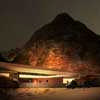
image from architect studio
The Wadi Rum Lodges winning competition entry by Chad Oppenheimer also has water resources as a central concern, here in the context of a desert resort. Located near Petra in Jordan, the proposed design reconciles the inhospitable (and water an energy-intensive) desert environment and an improbable program of luxury.
Grey and black water will be regenerated via onsite living machine wastewater reclamation, combined with the use of filtering cisterns, produce a somewhat closed system. The lodges are oriented appropriately for a hot dry climate to minimize solar gain. Ubiquitous thermal massing will mitigate the diurnal temperature swings of the desert, although it is questionable whether natural ventilation, generally reserved for hot humid climes, will effectively cool the project. Nevertheless, here again a systems sensibility and sensitivity to performance effectively reinforces the design parti.
EDEN Urban Art Wall, Sydney, NSW, Australia
Tony Owen Partners
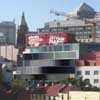
picture from architect practice
In Sydney, Tony Owen Partners’ EDEN Urban Art Wall apartments are playfully screened behind a vertically louvered façade; nuanced variations in louver color and hue produce patterns best appreciated on an urban scale. Yet the façade is central to the building’s performance, diffusing natural daylight and controlling direct solar heat gain.
It is in their unfailingly poetic, elegant, and economical response to constraints that natural systems serve as our best teachers. Imitating the appearance of natural systems in a kind of cartoonish biomimicry may serve as a pleasant decorative motif, but misses the opportunity afforded by a response that performs likes a natural system. Understanding the underlying forces at work in such a system, however, requires discipline, rigor and an openness to learn from failure.
Of the many distinguishing characteristics of living systems, a few key ones may be particularly instructive to architects. Living systems have no waste; the metabolic by-product of one organism in the system is a resource for others. Living systems are performance driven; they obey the inexorable laws of thermodynamics. Living systems are redundant and resilient; anyone who’s ever worked through a flashing detail understands these principles. Living systems are earthbound; we may eschew the Romantic conceit that beauty is absolute, but we have nevertheless evolved on a particular earth with a particular environment, and we are tuned to respond to that environment.
François Lévy
François Lévy is a registered architect and sometime university lecturer in Austin, Texas, USA. His forthcoming book on BIM for skin-load dominated sustainable design draws upon his advanced degrees in architecture and architectural engineering.
Comments on this Architectural Beauty article are welcome.
Latest article by François Lévy for e-architect:
Architectural Legibility and Didacticism – Aug 2011
Location: Austin, Texas, USA
International Architectural Designs
Architecture Context : article by Trevor Tucker. Sep 2010
Resisting Boredom : article by Joyce Hwang. Jan 2011
Sizing Identities : article by Sergio López-Piñeiro. Jan 2011
Design Narrative : article by Lee Miles – Sep 2010
Sustainable Buildings – Building Issues : article by Adrian Welch
Comments / photos for the Architecture Beauty – Article page welcome

